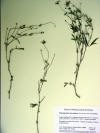|
Melampodium leucanthum |
|
|
Chaturvedula V. S., A. Farooq A, J. K. Schilling, S. Malone, I. Derveld, M. C. Werkhoven, J. H. Wisse, M. Ratsimbason and D. G. Kingston. 2004. New eudesmane derivatives from Melampodium camphoratum from the Suriname rainforest. J. Nat. Prod. 67: 2053–2057. “Bioassay-guided fractionation of an EtOAc extract of the leaves of Melampodium camphoratum using an assay for inhibitors of the degradation of hemin resulted in the isolation of six new eudesmane sesquiterpenes (1-6) and the known 6-epi-beta-verbesinol coumarate (7). The structures of compounds 1-6 were established as 6alpha-(4'-O-methyl-7'E-coumaryloxy)eudesm-4(14)-ene (1), 6alpha-({4'-O-stearyl}-7'E-coumaryloxy)eudesm-4(14)-ene (2), 6alpha-({4'-O-palmityl}-7'E-coumaryloxy)eudesm-4(14)-ene (3), 6alpha-({4'-O-[9' 'Z-hexadecenoyl]}-7'E-coumaryloxy)eudesm-4(14)-ene (4), 6alpha-(7'Z-coumaryloxy)eudesm-4(14)-ene (5), and 6alpha-({4'-acetoxy}-7'Z-coumaryloxy)eudesm-4(14)-ene (6). Compounds 1-4 showed weak activity in the hemin degradation assay, while compounds 5-7 were inactive.” |
|

